Related Research Articles

Flemish Brabant is a province of Flanders, one of the three regions of Belgium. It borders on the Belgian provinces of Antwerp, Limburg, Liège, Walloon Brabant, Hainaut and East Flanders. Flemish Brabant also surrounds the Brussels-Capital Region. Its capital is Leuven. It has an area of 2,118 km2 (818 sq mi) which is divided into two administrative districts containing 65 municipalities. As of January 2019, Flemish Brabant has a population of 1,146,175.
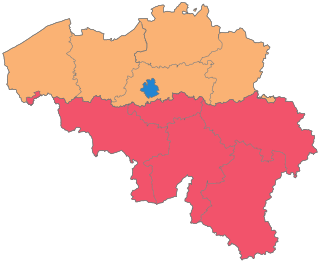
The country of Belgium is divided into three regions. Two of these regions, the Flemish Region or Flanders, and Walloon Region, or Wallonia, are each subdivided into five provinces. The third region, the Brussels Capital Region, is not divided into provinces, as it was originally only a small part of a province itself.

Tienen is a city and municipality in the province of Flemish Brabant, in Flanders, Belgium. The municipality comprises Tienen itself and the towns of Bost, Goetsenhoven, Hakendover, Kumtich, Oorbeek, Oplinter, Sint-Margriete-Houtem and Vissenaken.
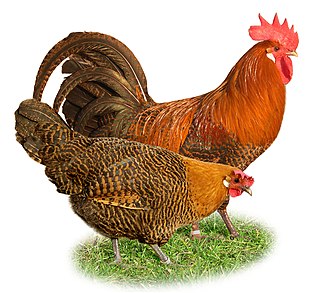
The Braekel or Brakel is a traditional Belgian breed of chicken. It is thought to have originated in the area of Brakel, in the Flemish province of East Flanders, for which it is named. There is a bantam version of the Braekel. The Campine of the United Kingdom derives from it.
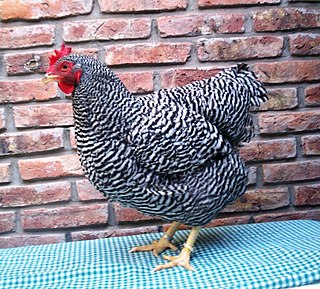
The Plymouth Rock is an American breed of domestic chicken. It was first seen in Massachusetts in the nineteenth century, and for much of the early twentieth century was the most popular chicken breed in the United States. It is a dual-purpose breed, raised both for its meat and for its brown eggs. It is resistant to cold, easy to manage, and a good sitter.

The Barbu d'Uccle or Belgian d'Uccle, Dutch: Ukkelse Baardkriel, is a Belgian breed of bearded bantam chicken. It was first bred in the town of Uccle on the outskirts of Brussels, in central Belgium, in the early years of the twentieth century. It is a true bantam, with no standard-sized large fowl counterpart, and is one of eleven Belgian true bantam breeds.

The Campine is a breed of domestic chicken originating in the northern part of Belgium. It is named for the Campine region of north-eastern Belgium and south-eastern Netherlands. It was known there as the Kempisch Hoen.

The Modern Game is a breed of ornamental chicken which originated in England between 1850 and 1900. Purely an exhibition bird, Modern Game were developed to be most aesthetically pleasing and to epitomize the visual appeal of the gamecock or fighting cock.
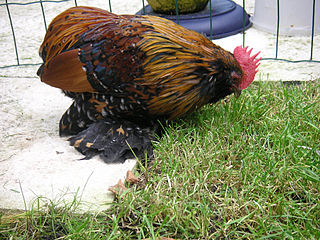
The Barbu d'Everberg, Dutch: Everbergse Baardkriel, is a Belgian breed of bantam chicken. It is a tailless variant of the Barbu d'Uccle, and was bred in about 1906 at the Château d'Everberg, at Everberg in the municipality of Kortenberg, between Brussels and Leuven. It is among the most endangered chicken breeds in Belgium, and in 2010 its conservation status was classed as "critical". It is a true bantam, with no large counterpart. Cocks weigh 700–800 grams, and hens 550–650 g.
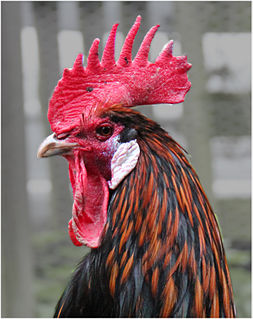
The Bergische Kräher is a German breed of domestic chicken from the Bergisches Land, in the state of North Rhine-Westphalia in western Germany. It is named for its unusually long crow, up to five times as long as that of other breeds, and belongs to the group of long-crowing chicken breeds, which are found from south-east Europe to the Far East.
The Belgian Bantam, Dutch: Belgisch kriel, French: Naine belge, is a breed of bantam chicken from Belgium. It is a true bantam, and has no full-sized counterpart; cocks weigh about 650 grams and hens about 550 g. It is in danger of extinction; in 2010 a total of 168 birds were counted in the whole of Belgium. Fourteen colour patterns are recognised in the European standard.

The Ardennaise, French: Poule ardennaise, is a breed of domestic chicken from the Ardennes plateau, in Belgium and eastern France. Its range extends from the Pays de Herve in Wallonia to the French département of Ardennes, and includes the Fagnes, the Famenne, and the valleys of the Amblève, the Ourthe and the Semois.

The Bergische Schlotterkamm is an old and endangered German breed of domestic chicken. It originates from the Bergisches Land, in the state of North Rhine-Westphalia in western Germany, and is one of three chicken breeds from that area, the others being the Bergische Kräher and the German creeper ("Krüper").
The Bassette Liégeoise or Bassette is a breed of large bantam chicken from Belgium. It is larger than most bantams, but much smaller than full-sized breeds; cocks weigh about 1000 grams and hens about 900 g. Like most Belgian bantam breeds, it is in danger of extinction. Eighteen colour patterns are officially recognised; many of them are rare.
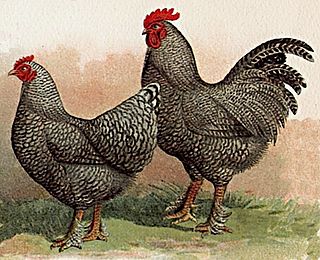
The Malines, Dutch: 'Mechelse Koekoek', is a Belgian breed of large domestic chicken. It originates from the area of Mechelen, in the province of Antwerp in Flanders, for which it is named. It was created in the nineteenth century by cross-breeding local cuckoo-patterned farm chickens with various different types of imported Oriental chicken. With the Jersey Giant, it is among the heaviest of all chicken breeds. It is valued for the quality of its meat, which is pale in colour and fine-textured.
The Coucou des Flandres, Dutch: Vlaamse Koekoek, is a critically-endangered Belgian breed of domestic chicken. It may have a common origin with the Malines from the area of Mechelen, in the province of Antwerp in Flanders, or may indeed represent the original type of that breed before it was cross-bred in the nineteenth century with various different types of imported Oriental chicken. By the time of the First World War it had disappeared; it was re-created in the years before the Second World War. It is critically endangered in Belgium, but more numerous in Picardy in France. It may also be known as the Poulet de Dendre, for the Dender river in its area of origin.

The Brugse Vechter, French: Combattant de Bruges, is an endangered Belgian breed of gamecock. It dates from the early nineteenth century, and was bred specifically for cock-fighting. It named for its area of origin, that of the city of Bruges (Brugge), in West Flanders in the north-east of Belgium. It is one of three Belgian breeds of fighting-cock, the others being the Luikse Vechter and the Tiense Vechter. It is a hardy breed, but the birds are often aggressive; those reared for exhibition may show less aggression.
The Luikse Vechter, French: Combattant de Liège, is an endangered Belgian breed of gamecock. It dates from the late nineteenth century, and was bred specifically for cock-fighting. It named for its area of origin, that of the city of Liège in Wallonia, in eastern central Belgium. It is one of three Belgian breeds of fighting-cock, the others being the Brugse Vechter and the Tiense Vechter.
The Yakido is a Japanese breed of fighting chicken. It belongs to the Shamo group of breeds. It was bred in Kansai region in southern Honshu in the mid-nineteenth century. It was made a Natural Monument of Japan in 1950.

The Flemish Horse, Dutch: Vlaams Paard, French: Cheval Flamand, is a Belgian breed of draught horse. It became extinct in the nineteenth century when it was merged with the Brabant to create the Belgian Draught. From about 1993 it was recreated from some stock kept by Amish people in the United States. A breed association, Het Vlaams Paard, was formed in 1999. In 2005 the breed was officially approved by the Flemish government, and the breed association authorised to manage the stud-book.
References
- 1 2 3 4 5 6 7 8 9 10 11 12 13 N. Moula, M. Jacquet, A. Verelst, N. Antoine-Moussiaux, F. Farnir, P. Leroy (2012). Les races de poules belges (in French). Annales de Médecine Vétérinaire156: 37-65. Accessed January 2017.
- 1 2 Liste des races et variétés homologuée dans les pays EE (28.04.2013). Entente Européenne d’Aviculture et de Cuniculture. Archived 16 June 2013.
- ↑ Breed data sheet: Tiense vechter/Belgium. Domestic Animal Diversity Information System of the Food and Agriculture Organization of the United Nations. Accessed January 2017.
- ↑ Tiense Vechter (in Dutch). Vereniging ter Promotie van Belgische Neerhofdieren. Accessed January 2017.
- ↑ Breed data sheet: Brugse vechter/Belgium. Domestic Animal Diversity Information System of the Food and Agriculture Organization of the United Nations. Accessed January 2017.